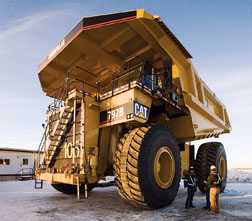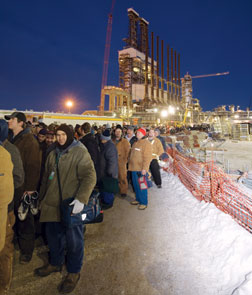 Michael Goodman / ENR GPS-equipped open-pit haulers carry nearly 400 tons per trip.
|
One of the biggest and most remote jobsites in the world lies in the vast emptiness of northern Alberta’s oil sands. North of Fort McMurray, which lies on the 56th parallel north, one degree up from Moscow, an assemblage of oil producers and construction workers are scrambling to ramp up production as the price of oil bounces between $90 and $100 a barrel. With production costs under $30, profit margins are huge. Arctic blasts whip across the boreal forest and muskeg plain once or twice a season, dropping temperatures to minus 40 degrees, where Celsius and Fahrenheit meet. But even that bone-rattling wind cannot chill the bonanza.
The region’s estimated reserves are 300 billion barrels; only Saudi Arabia has more. At today’s prices, producers can’t expand fast enough. They compete with each other for workers, building airstrips for Boeing 737s to shuttle them home across all Canada for breaks.
 Michael Goodman / ENR Workers queue up after day of construction. The median age of construction workers in the oil-sands region is 50 years.
|
Like star athletes, experienced trades people command hefty signing bonuses. They’re housed in modular, barracks-style work camps scattered among the major operations. Each worker has his own room, approximately 10 ft x 12 ft, with a bed, locker and telephone. A laundry, weight room, rec room and cafeteria are a few steps away. “It’s really all I need,” says Ed White, a 43-year-old equipment operator, who calls his family in Newfoundland nightly. “The days are long, and the money is good. I don’t have time to do anything but relax, watch a DVD and drink a Molson or two.”
Married couples get adjoining rooms. “The rooms in the camp are excellent,” says Rose Klatt, a laborer building the Horizon bitumen upgrader for Canadian Natural Resources Ltd., where her husband, Paul, also works as a pipefitter. “The food is good, too.” Camp cafeterias are outsourced to companies like U.K.-based Eurest Support Services. Camp residents get two hot meals a day, plus a sack lunch, as an employment benefit.
Stress
Fort McMurray’s population has doubled since 2000, to nearly 70,000 people, with projections for 100,000 by 2010. But that doesn’t include the “shadow population” of thousands more in construction camps north of town.
The town, which started as a trading post at the confluence of the Clearwater and Athabasca rivers, is the commercial center of the 68,450-sq-kilometer municipality of Wood Buffalo. First-term Mayor Melissa Blake is grappling with runaway growth. She is an articulate woman who once worked for producer Syncrude Canada Ltd. Her husband is a chemical engineer at Suncor Energy.
She ticks off the challenges of trying to govern during explosive prosperity. Spiralling housing prices top those in Edmonton and elsewhere in Alberta. The town has trouble attracting teachers, nurses, police and firefighters, “because they can’t afford to live here,” she says.
The oil majors routinely outbid the city for labor. Producers get special tax breaks. On top of that, taxes flow first to the province. Wood Buffalo residents feel that they fall behind Edmonton and Calgary when funds are disbursed. Thousands of workers living in the camps don’t pay local taxes, either.
One night in January, the pungent off-gas odors, which locals dub “the smell of money,” is barely noticeable. It’s about minus 10°C, unseasonably mild. At 5:50 p.m., a long queue forms inside the compound at CNRL’s Horizon plant. The mood is upbeat, almost playful, but orderly. It’s “brassing out” time for the day shift. About 1,600 workers shuffle through a small shack, swiping magnetic cards through three recorders on their way to buses parked outside the gate.
 |
| BLAKE |
Denis Dubord, a project manager for CNRL’s Edmonton-based contractor, PCL Industrial, helps direct traffic. But it’s hardly necessary. The workers—mostly male, but with a scattering of women—filter quickly through the exit gates to the parking lot. They board yellow school buses for the half-hour drive to one of four dorm-style camps. Others, foremen and those determined to live in town, board larger, more comfortable coaches. But their commute is a longer, 70-kilometer ride to residential neighborhoods of Fort McMurray.
Cold Snap
On Jan. 28, the mercury plummets to minus 40°C, shutting down operations at Syncrude and Suncor. At Horizon, PCL sends most workers home but keeps a small force on hand for snow removal and to provide essential services. It’s a tough call, and nobody likes it. There is work for piping and mechanical crews in enclosed...
 Related Links:
Related Links: 